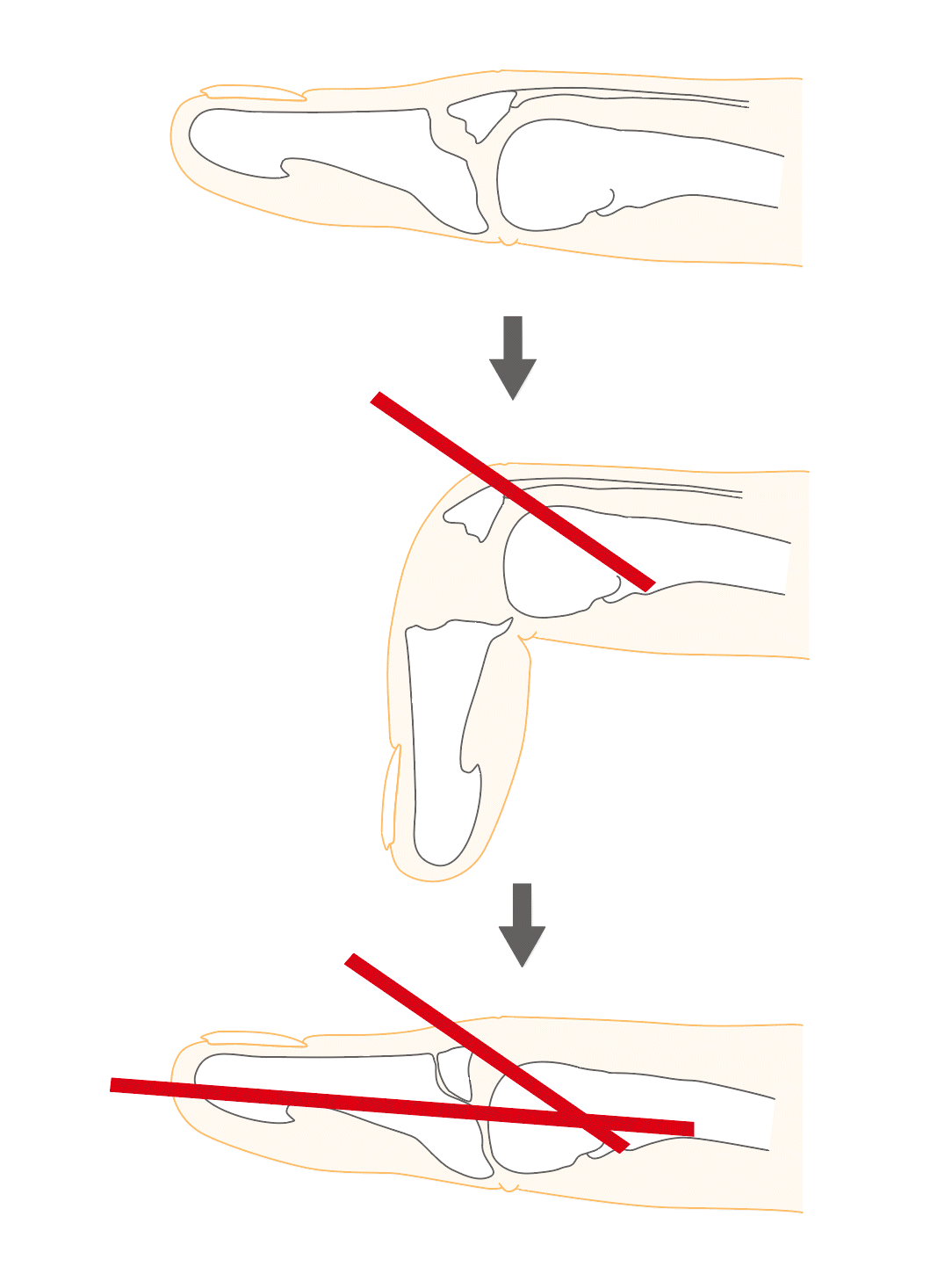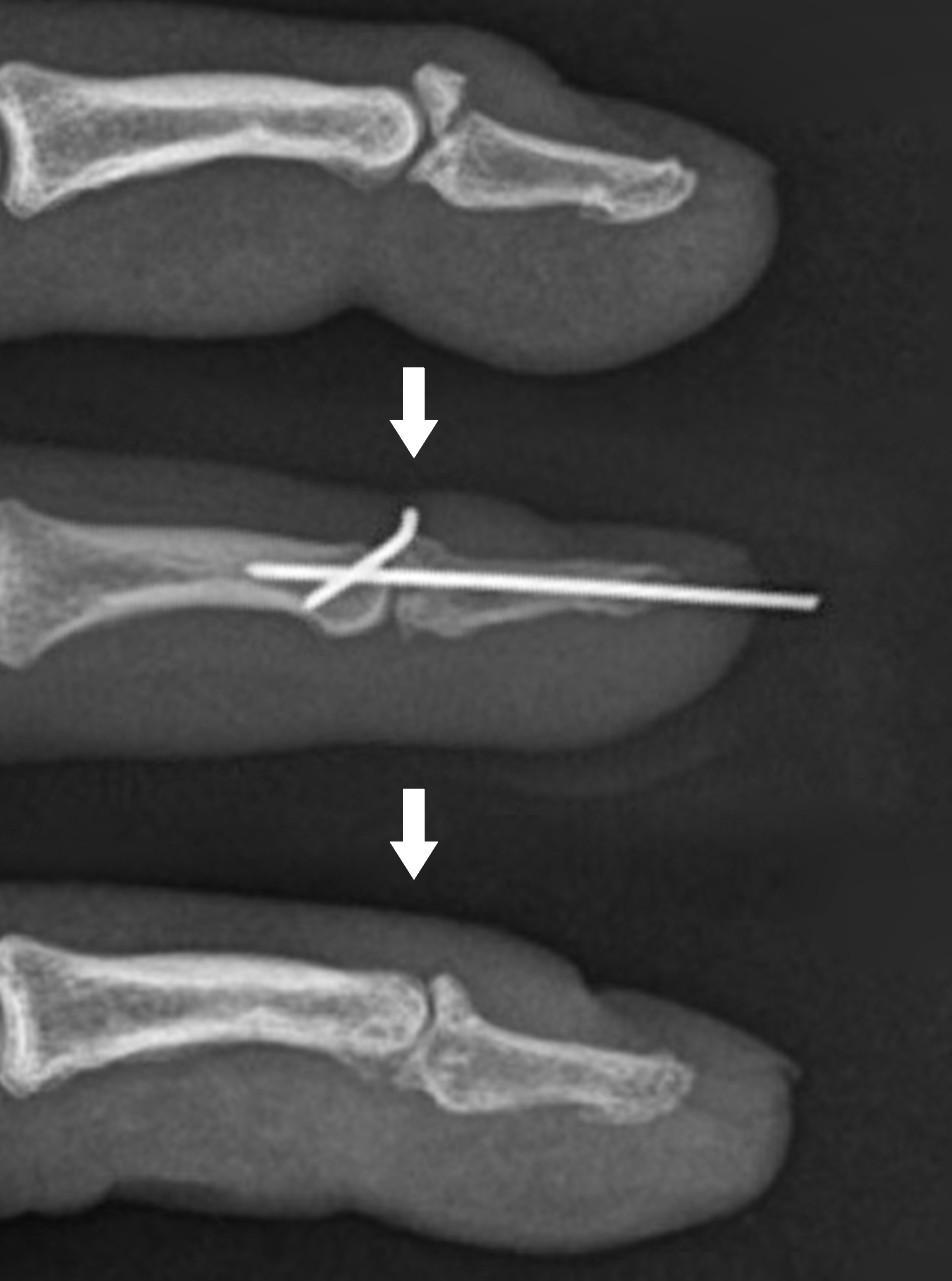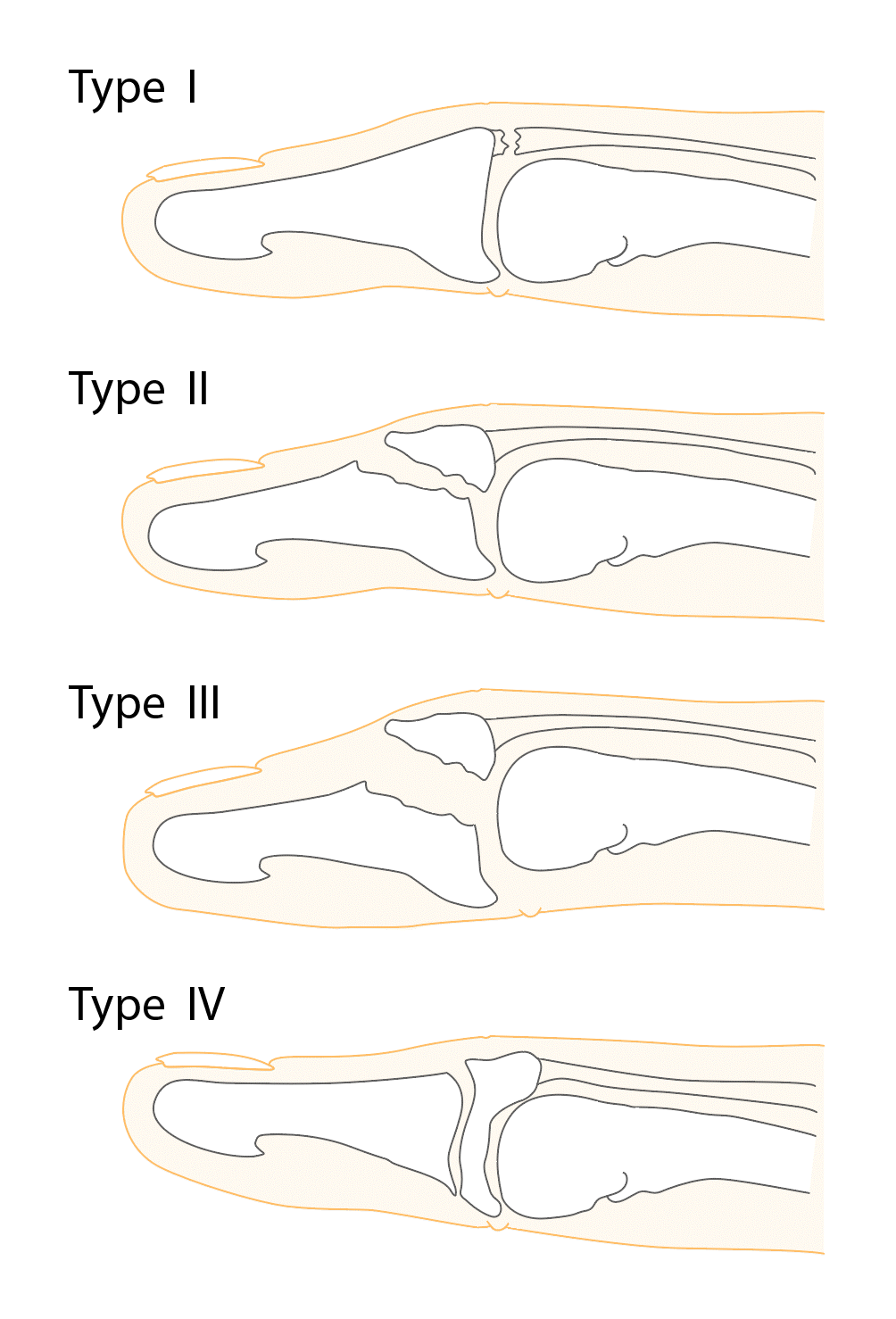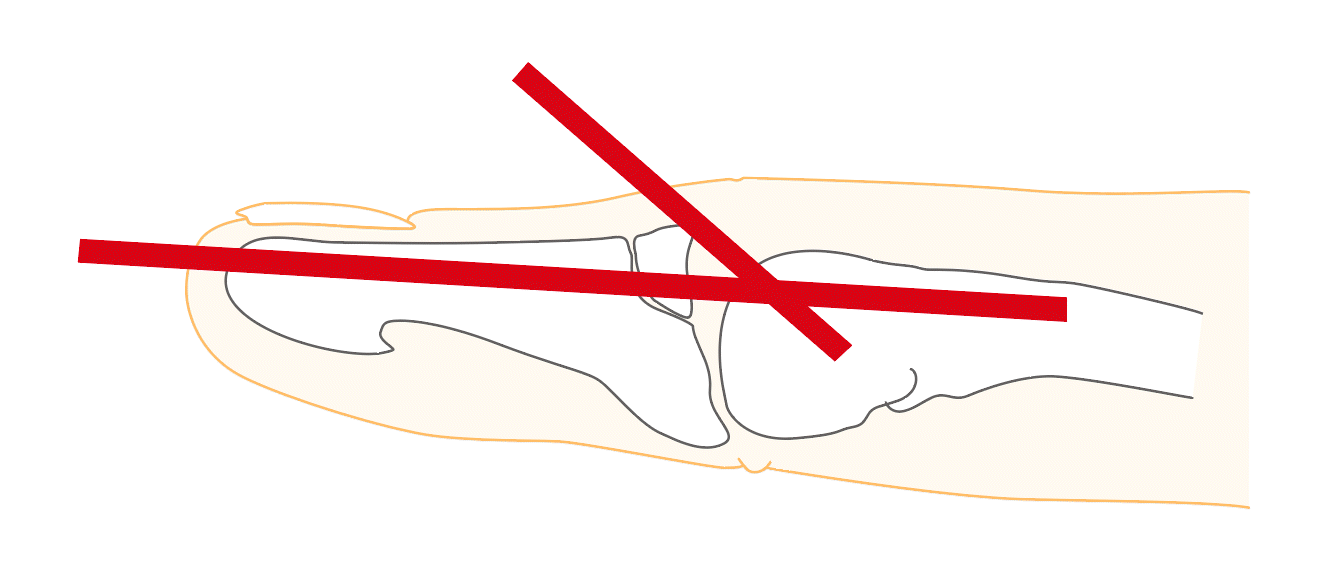This article has been
cited by other articles in ScienceCentral.
Abstract
Purpose
The purpose of this study is to investigate osteoarthritis after treatment of bony mallet finger using the extension block method.
Methods
A single institutional retrospective review identified 163 patients with bony mallet between January 2012 and July 2020 and received surgical treatment using extension block method. The radiographic examination showed that the fracture line disappeared and a bridging callus was formed and bone union was confirmed. Fractures were classified according to the Tubiana classification method. Demographic data, fracture pattern, postoperative X-ray, and late complications were analyzed. Clinical outcomes were analyzed using Crawford’s criteria.
Results
Surgical treatment was performed within an average of 8.8 days after injury, and the average follow-up period was 11.6 weeks. Osteoarthritis findings were confirmed by joint space narrowing and osteophytes on radiographic examination of 32 out of 163 patients. Age, sex, occupation, location of trauma, operation time, and type of fracture did not affect the osteoarthritis after extension block. Invasion of Kirschner wire (K-wire) to the fracture surface, family history of osteoarthritis, and operation time turned out to have a statistically significant effect on osteoarthritis (p<0.05).
Conclusions
Fracture surface invasion of K-wire and family history of osteoarthritis affect osteoarthritis after treatment of bony mallet.
Go to :

Keywords: Mallet finger, Osteoarthritis, Extension block
INTRODUCTION
Bony mallet is a type of avulsion fracture that occurs at the attachment of the extensor finger tendon at the base of the distal phalanx [
1]. There is a difference of opinion among the authors as to the treatment method for this. Depending on the severity of the fracture, conservative treatment or surgical treatment such as splint, cast, and immobilization device is performed [
2]. It has been reported that when bone fragment occupying more than 1/3 of the articular surface, subluxation of the distal phalanx, or dislocation of 3 mm or more is observed, surgery is recommended [
3,
4].
According to a study by Wehbé and Schneider [
5], good results can be obtained with nonsurgical treatment even in the presence of subluxation of the distal phalanx. However, many surgeons prefer surgical methods for the treatment of bony mallet when associated with large bone fragments and subluxation of distal phalanx [
1-
4]. Surgical treatment methods include small screw fixation, metal hook plate fixation method, pull-out wire method, and tension band wire fixation method. These operational methods are often associated with problems such as joint stiffness, soft tissue infection, nail deformity, joint surface mismatch, secondary deformity, and loss of distal joint extension after surgery [
6-
10].
The extension block method was introduced by Ishiguro in 1988. Since then, it has widely been used to treat bony mallet. It does not expose the fracture site, so it has excellent clinical results. Also, it can reduce distal phalanx subluxation, cause less rupture of bony fragments, and allow movement of adjacent joints after surgery [
11].
The Ishiguro extension block method has been modified and supplemented by many surgeons and tried in various ways, and since then it has been used as an alternative to treating bony mallet [
12]. However, it has also been reported that complications such as pin tract infection, nail deformity, skin necrosis, tendon rupture, and osteoarthritis (OA) appear after surgery [
13].
Therefore, the purpose of this study was to investigate late complications of extension block method, especially the causes of OA, one of the main complications that occurred after the treatment of bony mallet using the extension block method.
Go to :

MATERIALS AND METHODS
This study was conducted on 163 patients diagnosed with bony mallet between January 2012 and July 2020 and received surgical treatment using extension block method. The surgery was performed when the size of the bone fragment was greater than 1/3 of the articular surface and the fragment displacement was greater than 3 mm. Open fractures, comminuted fractures, multiple fractures, refractures, tendinous mallet, and history of OA or rheumatoid arthritis prior to injury were excluded.
Under brachial plexus anesthesia or local anesthesia depending on the patient’s condition, fracture plane was identified using fluoroscopic imaging. Interphalangeal joints were maximally flexed to allow one or two Kirschner wires (K-wires) to be inserted toward the center of the dorsal side of the head of the middle phalanx.
At this time, care should be taken not to create a gap between the bone fragments, and it was inserted distally at an angle of 45° from the head of the middle phalanx through the extensor tendon. The bone fragment is blocked by extension by 0.9-mm or 1.1-mm K-wire. One or two K-wires are used depending on the fracture type and the bone fragment undergoes reduction by manual operation that extends the distal phalanx. To fix the distal interphalangeal joint (DIPJ), another K-wire is used to maintain the reduction. In order to minimize the damage to the articular surface, it is recommended to perform it in a single maneuver (
Fig. 1). After surgery, an aluminum finger splint was applied, and active movement of the proximal interphalangeal joint and the metacarpophalangeal joint was enabled. Postoperative digital X-rays were taken at the outpatient clinic to check the dislocation and union of the bone fragments once every 1 to 2 weeks.
 | Fig. 1.
|
Cross-analysis and t-test were performed to determine whether there was a difference in the diagnosis of OA according to variables.
Based on medical records, the demographics, fracture site (thumb, index finger, middle finger, ring finger, and little finger), occupation (white-collar and blue-collar), family history of OA, underlying disease (hypertension and diabetes), and K-wire removal time were recorded. The arthritic change of DIPJ, type of fracture, timing of bone union, and the invasion of the fracture surface of the K-wire were checked through simple radiographs. The OA was diagnosed through narrowing of the joint space and osteophytes (
Fig. 2). The fractures were classified by the Tubiana method (
Fig. 3). The time of bone union was checked on simple radiographs taken during the timely outpatient follow-up when the fracture line was lost and the bridging callus was formed. Whether or not the K-wire inserted through the fractured gap was recorded by three experienced doctors through three times magnification images (
Fig. 4).
 | Fig. 2.Joint space narrowing is observed in the distal interphalangeal joint on X-ray after extension block. 
|
 | Fig. 3.Tubiana classifications. Type I, subcutaneous tendon rupture; type II, bony avulsion at the base of the distal phalanx; type III, fracture >1/3 of the articular surface with volar subluxation; type IV, growth plate fracture. 
|
 | Fig. 4.Kirschner wire invades fracture surface. 
|
The clinical outcome was evaluated using the Crawford criteria according to the pain, extension loss, and flexion in four stages; excellent, good, poor, and bad (
Table 1).
Table 1.
|
Classification |
Extension loss |
Flexion |
Pain |
|
Excellent |
None |
Full |
None |
|
Good |
0–10 |
Full |
None |
|
Poor |
10–25 |
Any loss of flexion |
None |
|
Bad |
>25 |
Any loss of flexion |
Persistent pain |

The study was conducted in accordance with the Declaration of Helsinki and written informed consent was obtained for publication of this original article and accompanying images.
Go to :

RESULTS
A total of 162 patients were analyzed, 115 males and 48 females. The mean age was 33.6 years (range, 9–77 years), and patients received surgical treatment within an average of 8.8 days after the initial injury. Mean follow-up period after discharge was 11.6 weeks (6 weeks–23 months). The average operation time was 39.2 minutes. The injured site was thumb in one case, index finger in 15 cases, middle finger in 40 cases, ring finger in 57 cases, and small finger in 50 cases. According to the Tubiana classification, type I was tendinous mallet, type II was avulsion fracture at the base of the distal phalanx, type III was fracture that involved more than 1/3 of the articular surface accompanied with subluxation, and type IV fracture was classified as a case of growth plate fracture. There were no case of type I and IV, 141 cases of type II, and 22 cases of type III. There were 142 patients without underlying disease, eight patients with hypertension, six patients with diabetes, and seven patients with both hypertension and diabetes. There were 77 cases of white-collar jobs and 86 cases of blue-collar jobs. On X-ray images, bone union was confirmed in all cases. The K-wire was removed at an average of 6.6 weeks after confirmation of bone union.
According to the Crawford criteria used for clinical evaluation, 63 patients were identified as excellent, 69 patients were good, 31 patients were poor, and no patient was bad (
Table 2).
Table 2.
Patient’s demographic data
|
Variable |
Data |
|
Age (yr) |
33.6 (9–77) |
|
Sex, male:female |
115:48 |
|
Preoperative period (day) |
8.8 (1–72) |
|
Timing of K-wire removal (wk) |
6.61 (6-11) |
|
Underlying disease |
|
|
None |
142 |
|
HTN |
8 |
|
DM |
6 |
|
HTN+DM |
7 |
|
Occupation |
|
|
White-collar |
77 |
|
Blue-collar |
86 |
|
Injured site |
|
|
Thumb |
1 |
|
Index finger |
15 |
|
Middle finger |
40 |
|
Ring finger |
57 |
|
Little finger |
50 |
|
Tubiana classification |
|
|
Type I |
0 |
|
Type II |
141 |
|
Type III |
22 |
|
Type IV |
0 |
|
Crawford criteria |
|
|
Excellent |
63 |
|
Good |
69 |
|
Fair |
31 |
|
Bad |
0 |
|
Complication |
32 of osteoarthritis |

Joint space narrowing and osteophytes were observed in 32 cases on X-ray images by an experienced radiologist, and the differences in OA diagnosis according to variables are as follows (
Table 3).
Table 3.
Statistical significance between postoperative osteoarthritis (OA) and variables using cross-analysis
|
Variable |
Category |
Diagnosis of OA
|
Total |
χ2 (p-value) |
|
No |
Yes |
|
Sex |
Male |
93 (80.9) |
22 (19.1) |
115 (100) |
0.062 (0.803) |
|
Female |
38 (79.2) |
10 (20.8) |
48 (100) |
|
Fracture site |
Thumb |
1 (100) |
0 (0) |
1 (100) |
2.440 (0.681) |
|
Index finger |
11 (73.3) |
4 (26.7) |
15 (100) |
|
Middle finger |
31 (77.5) |
9 (22.5) |
40 (100) |
|
Ring finger |
45 (78.9) |
12 (21.1) |
57 (100) |
|
Little finger |
43 (86.0) |
7 (14.0) |
50 (100) |
|
Fracture type |
II |
113 (80.1) |
28 (19.9) |
141 (100) |
0.034 (>0.999) |
|
III |
18 (81.8) |
4 (18.2) |
22 (100) |
|
Fracture site invasion of K-wire |
– |
125 (95.4) |
6 (4.6) |
131 (100) |
55.501 (<0.001)**
|
|
+ |
6 (18.8) |
26 (81.2) |
32 (100) |
|
Underlying disease |
– |
116 (81.7) |
26 (18.3) |
142 (100) |
3.522 (0.239) |
|
DM |
4 (66.7) |
2 (33.3) |
6 (100) |
|
HTN |
7 (87.5) |
1 (12.5) |
8 (100) |
|
Both |
4 (57.1) |
3 (42.9) |
7 (100) |
|
Family history of OA |
– |
131 (89.7) |
15 (10.3) |
146 (100) |
77.697 (<0.001)**
|
|
+ |
0 (0) |
17 (100) |
17 (100) |
|
Occupation |
White |
63 (81.8) |
14 (18.2) |
77 (100) |
0.405 (0.773) |
|
Blue |
68 (79.0) |
18 (21.0) |
86 (100) |
|
Crawford criteria |
Excellent |
63 (100) |
0 (0) |
63 (100) |
111.525 (<0.001)**
|
|
Good |
64 (92.8) |
5 (7.2) |
69 (100) |
|
Poor |
4 (12.9) |
27 (87.1) |
31 (100) |
|
Bad |
0 (0) |
0 (0) |
0 (0) |

Through cross-analysis (chi-square), sex, injury site, fracture classification by Tubiana classification, underlying disease, and occupation were not statistically significant in the diagnosis of OA. Twenty-six cases showed both postoperative OA and K-wire invading fracture surface. It was statistically significant that six cases were diagnosed with OA but their K-wires did not insert through the fractured gap. There were 17 cases of OA after surgery with a family history of OA and 15 cases without a family history of OA, which were statistically significant. According to the Crawford criteria ‘poor’, 27 cases were diagnosed with OA, and five cases were classified as ‘good’, which was also statistically significant.
Through t-test, the association between union time, follow-up period, K-wire removal time, time passed prior to surgery, and OA was investigated. None of them was statistically significant. The operation time was 44.94 minutes when OA was diagnosed and 37.88 minutes in the group without OA, which was statistically significant (
Table 4).
Table 4.
Statistical significance of postoperative osteoarthritis and variables using t-test
|
Variable |
No |
Yes |
t |
p-value |
|
Operation time (min) |
37.88±16.731 |
44.94±13.742 |
–2.490 |
0.016*
|
|
Union time (wk) |
6.51±2.338 |
6.84±2.216 |
–0.752 |
0.456 |
|
Follw-up (wk) |
10.65±6.854 |
15.69±16.998 |
–1.644 |
0.109 |
|
Preoperative period (day) |
7.53±8.515 |
14.00±30.154 |
–1.201 |
0.238 |

Go to :

DISCUSSION
Bony mallet occurs when the continuity of the extensor tendon is broken at the distal phalanx. It mainly appears in the form of avulsion fracture at the site where the extensor tendon attaches to the distal phalanx, resulting in extension lag of the distal phalanx [
9].
According to Robb [
14], the distribution of the injured finger was the highest in the order of the 4th and 5th fingers. In this study, the 4th finger was 57 cases, the 5th finger was 50 cases, and the 3rd finger was 40 cases.
Various nonsurgical and surgical treatment methods have been proposed for bony mallet, and the treatment results are controversial. According to Lin and Samora [
13], which compared nonsurgical and surgical treatment in general, both treatments showed excellent clinical outcomes. In a study of Lubahn [
15], surgery showed better results than nonsurgical treatment in terms of appearance and function, but Wehbé and Schneider [
5] recommend conservative treatment because the surgical treatment causes several complications. In many studies, it is known that the method using a splint or assistive devices is effective when the bone fragments are small. However, if more than 1/3 of the articular surface is involved or there is dislocation of the distal phalanx, surgical treatment is recommended [
6-
10].
Surgical treatment methods include compression pin fixation, screw fixation, intramedullary fixation, wire band fixation, pull out fixation, pull in fixation, and hook metal plate fixation as an open method. Modified extension block technique, umbrella handle technique, and so on are often recommended as closed techniques [
6-
10]. The extension block method proposed by Ishiguro in 1988 is widely used because of its simple technique and excellent clinical results. According to Hahn et al. [
16], it is known that the prognosis of the extension block method using K-wire is good when the patient’s age is young, there is no subluxation, and the reduction is accurate, especially when the mallet fragment angle is more than 30° [
16]. However, this method may also cause complications such as pin tract infection, implant failure, residual pain, and OA [
13].
According to the study data on treatment period, Wehbé and Schneider [
5] reported that the clinical outcome was not good when injury-treatment time interval was longer than 3 weeks while Ishiguro et al. [
11] reported that the clinical outcome was poor if delayed for more than 8 weeks. In this study, there were eight cases with a delay of more than 3 weeks and two cases with a delay of more than 8 weeks. Satisfactory clinical results were shown and no complications such as OA were found.
Poorer clinical outcome has been reported in the presence of subluxation [
16]. This was expected to be because, when accompanied with subluxation, even if the reduction was done correctly, certain amount of reduction occurred toward the direction of the subluxation, though it could not be observed by K-wire itself at the moment of fixation. In this study, there were 22 cases of Tubiana type III showing subluxation and 141 cases of bony mallet without subluxation, showing no difference in the incidence of OA.
Several studies have reported postoperative OA. However, there is a lack of research about the causes of the disease [
17-
19]. One patient out of 19 patients who received extension block method presented with OA in a study of Acar et al. [
19]. Six patients among 41 patients showed degenerative change of DIPJ in the study of Takami and Takahashi [
17,
19]. According to Khanna et al. [
20], repetitive K-wire insertion may be related to thermal damage to the bone and cartilage. It might cause mismatch of the articular surface, finally resulting in secondary posttraumatic (PT) OA [
20].
Primary OA is more common in middle-aged women and is known to progress over several years. However, PTOA affects relatively young group of adults. It is known that OA patients with joint trauma are more than 10 years younger than those without trauma. In addition, PTOA can occur as early as 1 year of the initial trauma. It is increasingly believed that the OA development in the injured joints initiates during the initial traumatic event by intraarticular pathogenic processes, such as apoptosis of articular chondrocytes, subchondral bone remodeling, cellular infiltration, and the release of inflammatory mediators in synovial fluid [
21].
In this study, the exact number of K-wire insertions could not be accurately recorded. However, it was expected that the longer the operation time is, the more K-wire insertions for fixation would be. In addition, as the operation time takes longer, the possibility of OA was expected to be higher.
Insertion through the fracture gap of the K-wire was correlated with the occurrence of OA, which is expected to cause arthritis due to the mismatch of the joint surface due to K-wire.
Although the extension block method scored Crawford criteria ‘excellent’ and obtained good results in many studies, 27 cases with poor prognosis were identified in this study, which implies that limitation of motion occurred due to the occurrence of OA.
This study has a limitation that postoperative range of motion and long-term data could not be obtained because patients without extension lag or other postoperative complications did not come to the outpatient center anymore after removing the K-wire. Further long-term studies are needed as we recommend revisiting for patients with a short-term follow-up period.
Go to :

CONCLUSION
Primary OA of the DIPJ is more common in middle-aged women. It is also known to occur more frequently in people with jobs with more mechanical stress. However, in this study, arthritis after using the extension block method occurred regardless of sex and occupation. It was found that family history of OA, K-wire insertion through the fracture gap, and longer operation time increase the incidence rate of OA.
Go to :






 PDF
PDF Citation
Citation Print
Print






 XML Download
XML Download